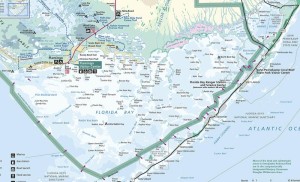Welcome to the Florida Everglades
When most people think of Everglades National Park, established December 6, 1947, they think of the “River of Grass” on the mainland of South Florida. There is more to the Park. Approximately 85% of Florida Bay lies within Everglades National Park. The map on the right, the green line is Everglades Park boundary, shows that most of the Upper Florida Keys lies on the Everglades Park’s Southeast border. The Florida Keys are part of Monroe County. The Map on the right shows that much of the Southwest portion of Everglades Park is in mainland Monroe County.
As you can see the Florida Everglades and the Florida Keys are closely linked.

Click on Picture for a larger view.
Florida Bay
Florida Bay is a shallow inner-shelf lagoon located at the southern end of the Florida Everglades watershed. It is an area where fresh water from the everglades mixes with the salty waters from the Gulf of Mexico to form an estuary that is surrounded by mangroves forests and encompasses over 200 mangrove islands. It’s nearly 1,000 square miles of interconnected basins, grassy mud banks, and mangrove islands are nesting, nursery, and/or feeding grounds for a host of marine animals: the American crocodile, the West Indian manatee, the loggerhead turtle, bottlenose dolphins, a variety of bird species and many game fish. Parts of the bay are also the nursery grounds for the economically valuable pink shrimp and Caribbean spiny lobster. Florida Bay is also important economically, supporting a 59 million dollar shrimp fishery and 22 million dollar stone crab fishery.Freshwater runoff into the lower Everglades/Florida Bay ecosystem has changed since the early 1900s, primarily due to extensive construction of canals and roads. Some believe that these changes in the water flow are the cause of current ecological problems in Florida Bay, while others believe they are a function of long-termed natural fluctuations.
There are other indications that the environmental health of Florida Bay has deteriorated. Fishing success has declined for many of the commercial and recreational species that depend upon the Bay as a juvenile nursery habitat, suggesting a decline in recruitment. Atypical algal blooms have been reported in the last few years across much of western Florida Bay and have extended into the Florida Keys. These blooms are thought to have attributed to the Loggerhead sponge die-off. This is significant because these sponges are the habitat for juvenile lobster. Most recently, mangroves within the Bay are reported to be in decline. While the causes of the various problems and the relationships between them are not well understood, there is no question that, like the sawgrass habitat of the Everglades, the coastal marine ecosystem of Florida Bay is in jeopardy.
More freshwater alone will not return Florida Bay to its pristine condition. The timing, location, and quality of freshwater released to Florida Bay must also be considered. Water quality is particularly important, and measures to address pollution specific to the Everglades may not be adequate to protect Florida Bay. Increasing freshwater flow to the Bay, all else being equal, could increase nutrient loading which might induce more frequent and more extensive phytoplankton blooms. These could, in turn, result in further losses of bottom vegetation in the Bay from light limitation, and nutrient loads in Bay waters that exit between the Keys could be injurious to the coral reefs of the Florida Keys Marine Sanctuary. Lastly, increasing water flow could also increase trace contaminant loading depending on sources and flow pathways.
